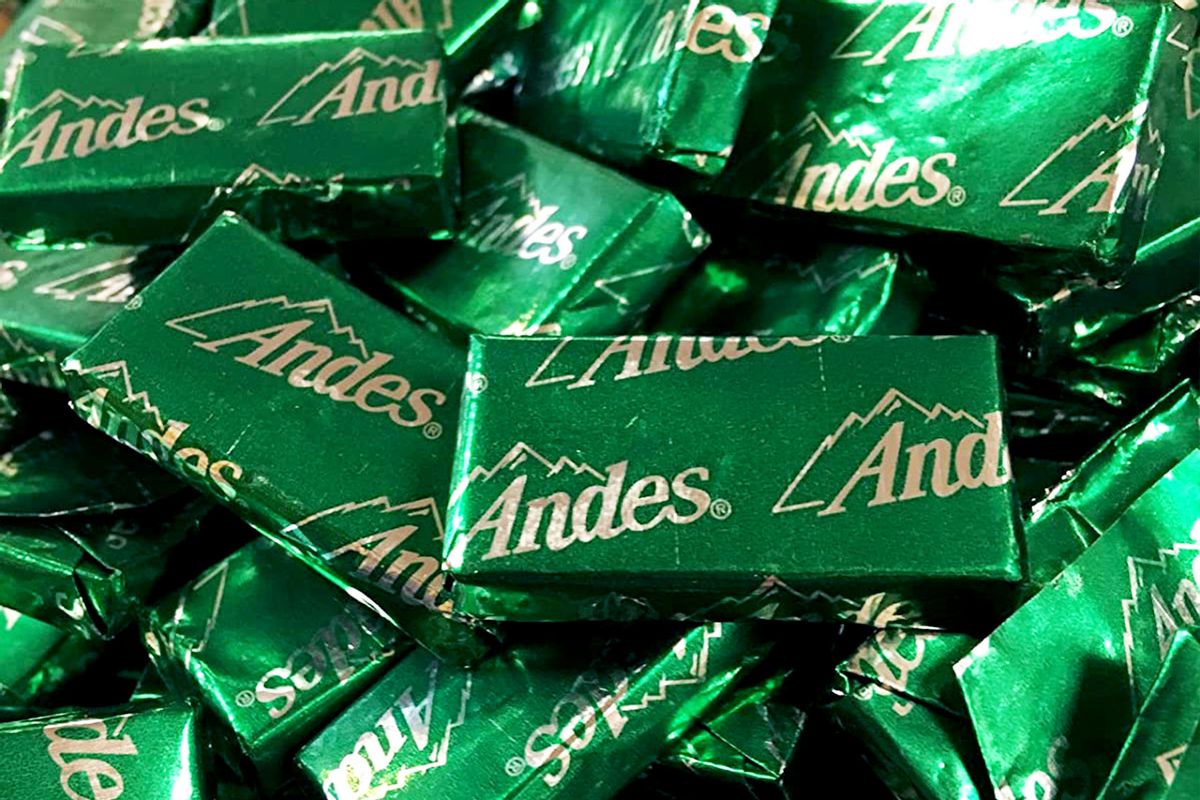From Olive Garden to fine dining, how Andes Mints became part of eating out in America

There’s something deliciously old-school about the way a thin, chocolate-covered mint ushers diners through the brief liminal space that exists between dinner and after-dinner. It begins after the check arrives and there’s a gradual change in the rhythm established during the meal: stories that have unspooled over the evening reach their end, along with the wine, and the conversation start-stops a bit as people reach for their wallets and adjust their weight away from the table.
This is when a chocolate-covered mint is best enjoyed — amid the flurry of finding jackets and mittens and calculating the tip — the milky, slightly saccharine surface giving way to a tingling chill that coats your tongue and the inside of your cheeks, momentarily blending with and then masking any lingering traces of dinner.
When I think of the types of restaurants that still provide a chocolate after-dinner mint with the check, I think of steakhouses and red sauce joints, places with hearty entrees, linen tablecloths and whose kitchens are probably brimming with the round, sumptuous scent of garlic frizzling in olive oil. It makes sense that there would be an association with traditional dining. Mint has long been used as a digestive aid after dinner.
One of the oldest surviving medical texts in the world, the ancient Egyptian Ebers Papyrus from 1550 BC, cites mint as a digestive, while in 1597, John Gerard, author of “The Herball” recommended it for “stomacke” ache. Through time, there have been numerous after-dinner mint companies, one of the most famous being Altoids. Created at the turn of the 19th century by London confectioner William Smith, he marketed his mints — which were made from sugar, gum arabic, peppermint oil, gelatin and glucose syrup — as “a stomach calmative to relieve intestinal discomfort.”
One could argue (and I do) that chocolate-covered mints are slightly more confection than medicine in their composition. Similar to breath mints, there are multiple brands like After Eight and Philadelphia Candies, however, the one that feels most synonymous with really dining out is Andes Chocolate Mints.
According to a representative from Tootsie Roll Industries, which acquired Andes Mints in 2000 from candymaker E.J. Brach, “Andes Mints were created by Chicago candy store owner Andrew Kanelos in 1921.” Initially, his store was called Andy’s Candies, named after himself, but he later changed the spelling of the business to Andes Candies; according to Chicago lore, it was because he heard from male customers that they didn’t like giving their wives and girlfriends candy with another man’s name on it (though Tootsie Roll Industries didn’t comment on that aspect of the business name change).
Today, Andes Mints are made in Wisconsin and are distributed domestically and internationally to many countries. When I asked if marketing to restaurants has been a key part of the Andes Mints strategy, the company’s public relations representative demurred a bit, writing only that “the specialness of the product has always lent itself to after dinner treats, milkshakes, ice cream and coffee.”
Want more great food writing and recipes? Subscribe to Salon Food’s newsletter, The Bite.
However, the connection is undeniable and just splendidly nostalgic. The Portland Hunt & Alpine Club, a Scandinavian small plates and cocktail bar owned by Briana and Andrew Volk in Maine, still doles Andes Mints out for customers, while Jim’s Spaghetti House in Huntington, West Virginia, only recently did away with the tradition after being in business since 1938. They’re found in fishbowls on hostess stands in New Jersey diners, Chicago rib joints and the Ahwahnee Hotel’s restaurant in Yosemite — all places that emit a kind of old-school cool.
That said, most diners with whom I spoke associated Andes Mints with Olive Garden and with good reason.
“We first partnered with Andes in 1986 – just two years after Olive Garden opened – and we’ve been serving our specially-made Andes After-Dinner Mints ever since,” Jaime Bunker, the senior vice president of marketing at Olive Garden, said in an email.
According to Tootsie Roll Inc., the after-dinner mints they make for the chain “[are] similar in flavor to a traditional Andes, wrapped in silver foil with the Olive Garden logo” instead of the traditional emerald green etched with a minimalistic illustration of mountain peaks.
“The reason the mints have endured at Olive Garden for so long is because they represent one of our core values: treating everyone as family,” Bunker continued. “A complimentary mint after our guests have enjoyed a nice meal with us is our way of saying ‘Grazie.’ Plus — they’re delicious!”
Read more
from this author


